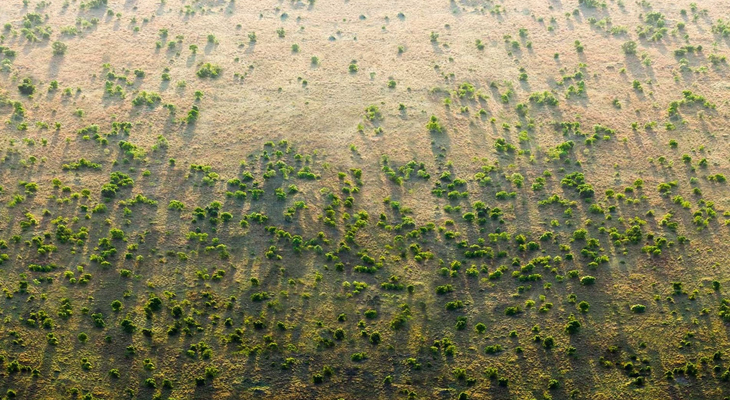
Land Management: A step towards mitigating Land Degradation
Published 17 June 2020 by Himanshu Burad under Sustainable Development

Land Management: A step towards mitigating Land Degradation
According to the United Nations, land degradation is explained as the “reduction or loss of the biological or economic productivity and complexity of rain-fed cropland, irrigative cropland, or range, pasture, forest, and woodlands resulting from land uses or from a process or combination of processes arising from human activities.” 1 Land degradation could be physical, chemical or biological in nature.
The drivers of land degradation could be direct or indirect. The direct drivers are agriculture and forestry, urbanisation, infrastructure development, energy production, and mining and quarrying.2 While growing population, increasing consumption of goods and services that are produced using tangible natural resources like land, water are the indirect drivers of land degradation. For example, vegetative capacity of soil in crop land decreases due to excessive crop production; over-grazing of livestock degrades grasslands; and deforestation of forest lands to make more space for crop lands beyond the regenerating capacity of land decreases the tropical zones which act as natural carbon sink to the atmosphere. Additionally, land ecosystems are degrading due to rapid burning of fossil fuels which in turn rises atmospheric temperature and nutrient absorption abilities of soil changes due to heat that causes dryness or increases aridity in soil.
Why is it important to be addressed?
“Land is undergoing human pressure, land is part of the solution, but land cannot do it all” by Debra Roberts, Intergovernmental Panel on Climate Change (IPCC). The underlying principle with Land degradation neutrality is security of all stakeholders which includes ecosystem, climate, human, food, energy, water and urban security.3 Mitigating land degradation is fundamentally an integrated landscape management principle. Some of the mitigation techniques practised in regions around the world can be the solution to this problem.
Tanzania and Denmark include local community in decision making for participatory land use planning through legal framework. Land use planning helps in doing the right thing in the right place at the right scale. Northern Negev in Israel is the interface between arid and semi-arid climate. Due to over grazing and intensive agriculture, the fertility of land has been extensively degraded. Privatisation and economic incentives have facilitated land restoration in the region.
The Northern Triangle of Central America which is also referred to as the Trifinio territory comprises of marginalized areas on the frontier areas of Central American nations of Guatemala, El Salvador, and Honduras. The people in this region depend on slash and burn agriculture for their livelihood. Due to land degradation in the region, in the year of 2014, the region adopted integrated landscape management model. The model is founded on the principles of participation, negotiation, and cooperation, and long-term collaboration among diverse stakeholders to achieve multiple objectives that aimed at improving the management of natural, human, and social capital, and thereby increasing resilience to climate change. Simple to use innovations in the management of water, solid waste, soil management, and crop production empowers local people to contribute to larger conservation goals while also addressing to food security with nutritious source of food.
Sikkim,a state in India was the first to go fully organic. It is now a model state for the world because agriculture is done keeping in sync with the services of the nature.It protects them without forgoing productivity as well as keeping up with the development of the state. Bhutan, too, in the year 2011 had set a target to transform their country’s agriculture to cent percent organic by the year 2020. Their strategy has been to take gradual steps, by first expanding region wide, then going product wide with simultaneous innovations to find ways to curb diseases and improve crop yields.
The interaction of rural communities with the urban areas is distinct in two different ways: one is in sub-urban areas and other in immediate rural environment.4 As urban areas expand the demand for food, water increases that adds the pressure on its surrounding ecosystems. In order to reduce the environmental costs of urban mobility, food, and energy, cities have to be designed with an aim of sustainability. The state intervention would be warranted in this by the way of planning which will also create new opportunities for recycling and resource efficiency. For example, in Bogotá, Colombia the capital city enjoys clean water, courtesy of several protected areas and other conserved watersheds. Over 80 per cent of the population receive their drinking water from Chingaza National Park, an area where the region’s native habitat is conserved.5
In order to support the underlying social and economic conditions, there is a need for creating an enabling environment that allow for feasible and sustained progress, specifically those connected to stakeholder engagement, land tenure, gender equality, and the availability of sustained investment and infrastructure. For example, by taking the model of Kubuqi desert in China, where a Great Green wall of trees, shrubs, and grasses were planted since 1978 to protect northern cities which falls in the Western part of China from experiencing the risk of desertification. By 2010, nearly 12,452 square kilometre of degraded land had been rehabilitated, but on the flipside, there has been increasing desertification. A similar approach of building a Great Green wall 6 for the Sahara and Sahel regions in Africa 7 was adopted by African Union in the year 2007.8 The initiative was a harmonised regional strategy to create a mosaic of green and productive landscapes across North Africa, the Sahel, and the Horn. The wall has been aimed to reverse land degradation by 2025, and achieve regional transformation of the land by 2050. The initiatives taken so far in countries like Ethiopia, Burkina Faso, Nigeria, Senegal and Sudan include restoring the degraded land by planting native plant saplings, improving watershed regions, training youths and employing them as forest guards are a few to mention.
While in Peruvian Altiplano, which is one of the world’s poorest areas has high climatic variability, high altitude, land fragmentation, and limited access to markets and financial resources drive highly diverse and complex potato-based farming and low productivity livestock systems. An integrated systems approach was deployed in the region which improved productivity of farm, per capita incomes, and resilience of farming systems which in turn reduced vulnerability. It especially empowered women farmers in the region. They are encouraged to practice mixed farming that includes quinoa cropping (native grain crop), dairy farming, and trout farming.
All the practices discussed spans across all the geographical frontiers and hints that there cannot be a ‘one size fits all’ approach which could be robust across regions around the world. Every country and every state within the country based on their geography, sociological and livelihood challenges, they have devised their own strategy which is localised. It is grounded in the very place of which it plans to solve. Land degradation is an evolving issue that ought to be addressed through integrated land management approaches with region-specific land use planning.
References:
- CATEGORISATION SYSTEM FOR THE CIRCULAR ECONOMY. European Commission. PDF file.
https://circulareconomy.europa.eu/platform/sites/default/files/ki0420074enn.en_.pdf - GLOBAL LAND OUTLOOK. United Nations Convention to Combat Desertification. PDF file.
https://www.unccd.int/sites/default/files/documents/2017-09/GLO_Full_Report_low_res.pdf - Ibid
- Ibid
- Ibid
- Great Green Wall. “Great Green Wall — The Great Green Wall.” Accessed June 15, 2020.
https://www.greatgreenwall.org/about-great-green-wall. - “The Great Green Wall Initiative | UNCCD.” Accessed June 15, 2020.
https://www.unccd.int/actions/great-green-wall-initiative. - GLOBAL LAND OUTLOOK. United Nations Convention to Combat Desertification. PDF file.
https://www.unccd.int/sites/default/files/documents/2017-09/GLO_Full_Report_low_res.pdf
Recent Articles
- India's March for Sustainable Future
- Water Insecurity in India
- A New Paradigm in the Financing of Solar Energy Projects
- Land Management: A step towards mitigating Land Degradation
- Impact of COVID-19 on Water Issues and the Way Forward
- Humanity better off with world order without ‘Chinese characteristics’
- Models to Make Vocational Training Work in India
- Will Seed Bill 2019 deliver the goods?
- Stubble Burning Farmers: Architects of Delhi’s Breathing Woes, or Hapless Scapegoats?
- Does India Need More Policy Action for Its Senior Citizens?
- Creating a future-proof curriculum for the digital age
- Policymakers, wake up! Floods in Chennai are not Alarm bells, they are explosions
- 'Environmental Finance — Private Capital and Private Profits for Public Gain— Pretty Promising, though not without Pain'
- Inclusive Innovations in Education Praxis
- Antibiotic Resistance: Fighting a Multi-Headed Demon

